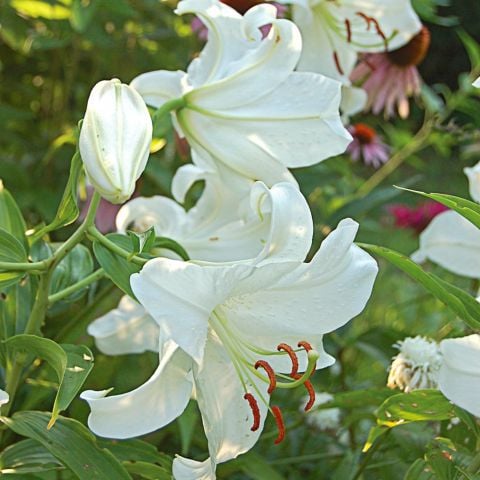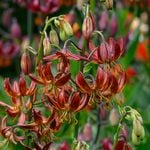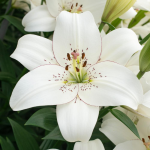Lily Plant Care
Latin Name Pronunciation: lil'ee-um
Bulb size: 18-20 cm
Lilies are among the truly great garden plants. Their beauty, diversity, extended season of bloom, exquisite fragrance, graceful stature, and reliable disposition reflect the fruits of hundreds of years of selective breeding in the genus Lilium. Your garden should not be without Lilies, whether you manage acres of mixed borders or a few pots on a city balcony.
Lilies produce spectacular trumpet-shaped flowers atop strong stems that arise from bulbs made up of scale-like segments. Heights vary according to variety, ranging from 2–6' or so. All are elegant in the perennial border and shorter varieties may be successfully grown in pots. Plant in an area sheltered from strong winds, and plan on staking the taller types.
Lilies are indispensable for cutting, and a single stem in a vase makes a classic statement; remove stamens to avoid contact with the pollen, which may cause stubborn stains. If you don't like to cut from your beautiful borders, plant rows of Lily bulbs in a cutting bed or in a corner of the vegetable garden.
How to Grow Lilies
Light/Watering: Most of today's Lilies prefer full sun but will flower in partial shade, which may also help the blooms retain their color. Some of the species Lilies and their kin prefer afternoon shade, and require it in the hottest climates. Lilies thrive with regular watering, especially during periods of summer drought.
Fertilizer/Soil and pH: Lily bulbs will not survive if soils are poorly drained, especially in the winter months. Some will form roots along the buried stems and will appreciate a side dressing of organic matter, and all will benefit from a summer mulch to keep roots cool. Light, loamy soils that are well drained and have a pH right around 6.0 are ideal. Plant Lily bulbs three times as deep as the bulb is high, except for L. candidum and its cultivars, which should only be covered with an inch of soil. Feed in early spring as growth emerges and again just as the flowers open. If a soil test indicates a low level of potassium, supplement with muriate of potash or a fertilizer high in this nutrient for optimum bulb and root growth.
Pests/Diseases: Gardeners in the Northeast must be on the lookout for a relatively new pest called the Lily leaf beetle, which feeds on Lily foliage, buds, and flowers in both its larval and adult form. Luckily, both life stages are easily recognized: the adult is slightly less than half-an-inch long, with a brilliant scarlet body and black head and appendages. The larvae look a bit like lumpy slugs but are orange, brown, or greenish yellow with black heads; they pile their black excrement on their backs as they feed. From March through June, look on the undersides of the leaves for the orange eggs and destroy them. Handpicking works if only a few plants are present; for a larger planting, Neem products are effective for young larvae and will deter adults, and insecticides containing spinosad will control the insect (but avoid using these when bees are active). Occasionally, aphids will infect Lilies with Lily mosaic virus, which results in yellow streaking or mottling of the leaves; this virus is mainly problematic in the species. Watch for aphids and rinse off with a forceful water spray.
Coping with Lily Leaf Beetles
Companion Plants: Lilies do very well in the company of shallow-rooted plants, which also help to keep their roots cool. They are especially lovely rising from a bed of deep green Ferns, and many varieties flower at the same time as Roses, Peonies and Clematis.
Because they are tall and slender, Lilies fit easily between other plants. Tuck two or three between the crowns of other perennials, towards the back of the border. Lilies can add color where Peonies, Baptisia, and other early summer bloomers have subsided to green. Lilies can also complement summer bloomers. Try Asiatic Lilies, which bloom first, with Salvia, Geranium, Centaurea, or Heuchera. Orienpet Lilies (crosses between Trumpet and Oriental Lilies) are the next group to bloom. They enhance Campanulas and all the Daisy-type flowers: Echinacea, Coreopsis, Gaillardia, Leucanthemum. Oriental Lilies, the last to bloom, are lovely with Phlox, Ornamental Grasses, and Sedum, as well as the long-blooming Echinaceas.
Reflowering: Remove flowers as they fade to avoid the formation of seedpods (this directs energy back to the bulb, rather than to seeds). When all flowers have passed, cut the stem directly below the blooms, so that as much foliage is left as possible to feed the bulb. Also, when cutting flowers for the house keep the stems as short as possible for the same reason.
Dividing/Transplanting: Lily bulbs go dormant in late fall, and that is the best time to move or divide the clumps. Handle the fleshy bulbs carefully, and replant at the same depth in well-drained, friable soil. If smaller offset bulbs are present, replant these at a depth three times their height.
Calendar of Care
Early Spring: Apply a light application of balanced fertilizer or side-dress with compost and organic amendments when new growth appears. Check potassium levels in the soil if plants appear weak. Water well if it is unseasonably dry, as plants prefer evenly moist soil.
Mid-Spring: In the Northeast, watch for Lily leaf beetle activity. From March through June look beneath the foliage for the orange or red eggs and destroy. If it is impossible to handpick the larvae and bright red adults, treat with Neem products or those containing spinosad. Watch for aphid infestations; wash off with a forceful water spray or spray with insecticidal soap. Mulch plants as soil warms to buffer soil moisture and temperature.
Late Spring: Taller forms may need staking.
Summer: Water Lilies well during dry spells. Remove flowers as they fade and when blooming is finished cut the stem right below the last bloom to leave as much foliage on the plant as possible.
Fall: Cut foliage back and remove from the garden. Clumps of Lilies may be divided or transplanted after foliage dies back in late fall.
Note: Spring-planted Lilies will likely be a little shorter than expected their first year; the bulbs are so eager to grow, they produce stems before they're fully rooted. In their second year in your garden, the Lilies will achieve their full, often majestic, height. Orienpets and Orientals might benefit from staking in their second year, especially if grown in part sun, because they tend to lean towards the sunlight.
Where and How to Grow Lilies
Types of Lilies
There are a handful of plants that have ‘Lily’ in their name, leading one to believe they’re all members of the Lilium family—but that’s not the case. Calla Lilies, for example, belong to the genus Zantedeschia and aren’t true lilies. The Canna Lily is in the family Cannaceae. Daylilies are from another genus entirely, as we explain below. Following are some types of true Lilies in the family Lilium.
Oriental and Orienpet Lilies
Oriental Lilies are best known for their perfume and late-summer bloom. Crimson-and-white 'Star Gazer' is still popular as a cut flower after 25 years in the trade. Pure white 'Casa Blanca' has taller stems, to 4' or more, and lights up a summer evening in the garden. Crosses of Oriental Lilies with the taller, also fragrant, Trumpet Lilies have created an exciting new group of Lilies, dubbed Orienpets. These hybrids combine the best of both parents and fill the gap in bloom time between the two.
Asiatic Lilies
These early-blooming Lilies are all hybrids of Asiatic species, and you’ll look for a long time to find a more colorful and vigorous group of plants. Colors range from the softest pastels to fiery reds and oranges that practically ignite in the sun. Blooms vary from simple open bowls to exquisitely recurved flowers so delicate you can’t imagine how they stand up to the weather. However, these Lilies are as sturdy as young trees, with stems seldom reaching above 4ft, short enough never to need staking. Of course, their straight stems and heavy bud count make them superb cut flowers. We suggest patches of single colors for the mixed border and large drifts of our Naturalizing Lily Mixtures for a long-running show where the garden meets the wild.
Trumpet Lilies
The lovely, trumpet-shaped flowers of this group are borne on long graceful stems. Their intoxicating scent can perfume an entire garden.
Types of Lilies
Frequently Asked Questions
Daylily vs. Lily?
True Lilies, from the genus Lilium, are often confused with Daylilies (Hemerocallis). True Lilies produce a single stem, often tall, from a bulb. The leaves grow on the stem. Daylilies grow from tubers that produce a large tuft of foliage, from which emerge leafless stems (called scapes).
When do Lilies bloom?
Lilies bloom once a year for 2–3 weeks during summer months. The exact timing depends on the variety. You can have a full season of color by planting varieties that bloom at different times.
Can you grow Lilies in pots?
Yes. Lilies thrive planted in pots in sunny locations. This is a good idea if you live in a northern growing Zone and want to plant tender varieties which may not survive winter in the ground. Fill a large size container equipped with drain holes with a rich planting mix and plant several Lily bulbs 4" deep. Work in slow-release fertilizer on the soil surface. Bring pots indoors before a hard frost.
What to do with Lilies in pots after flowering?
Whether your Lilies are planted in pots or in the ground, deadheading the faded blooms will encourage re-flowering. Fertilize monthly during the summer months. Bring pots indoors before the first hard frost. The bulbs can overwinter in the pots in a cool (but not freezing), sheltered spot, such as an unheated garage.
Shop Lilies
Lily Bulbs We Offer:
 Lilium 'Casa Blanca'
Lilium 'Casa Blanca'
Lily Flower Images
Lily Bouquets:
 Fragrant White Lily Bouquet
Fragrant White Lily Bouquet
 Perfumed Garden Lily Bouquet
Perfumed Garden Lily Bouquet







